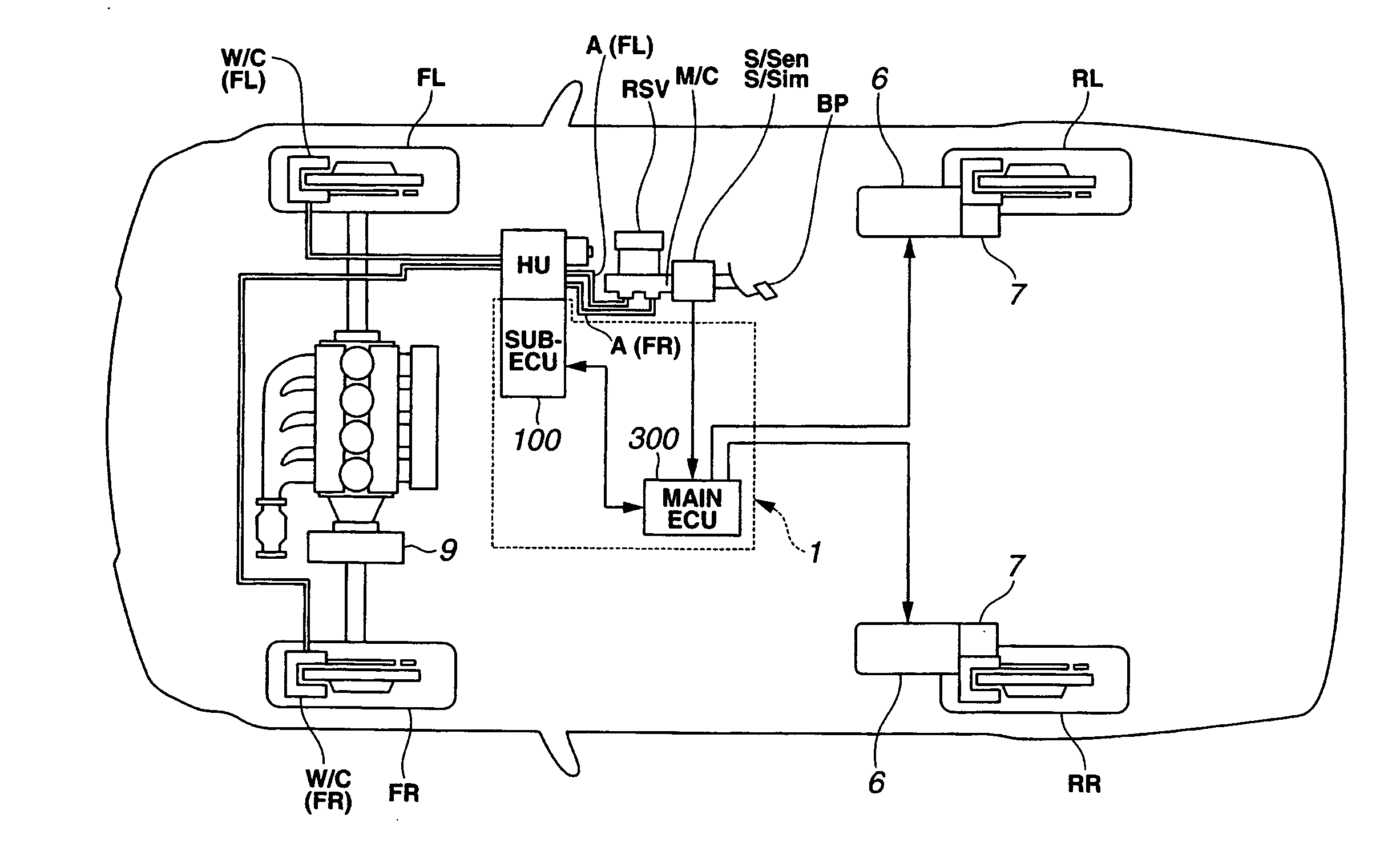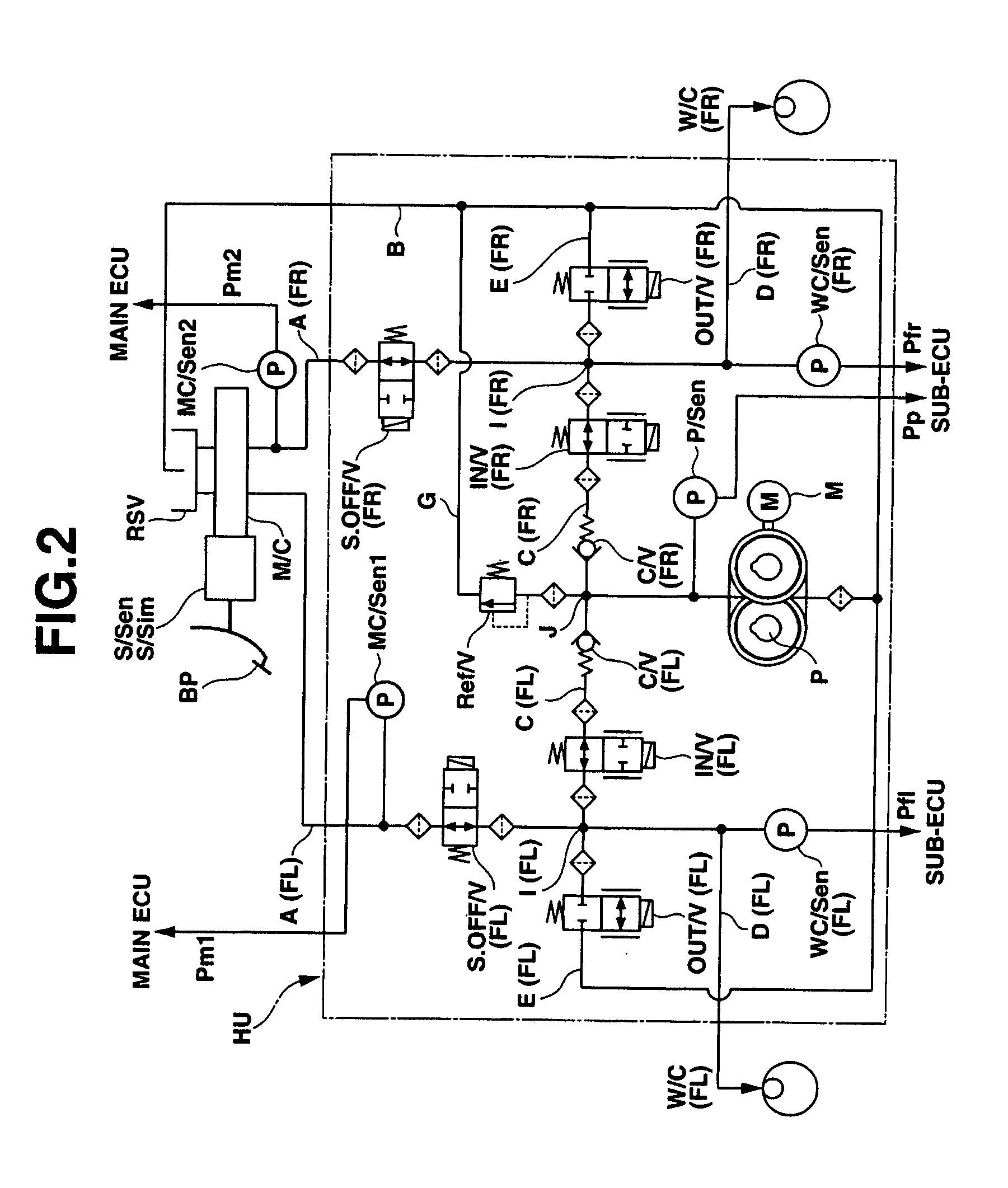Brake control apparatus and pump-up system
- Summary
- Abstract
- Description
- Claims
- Application Information
AI Technical Summary
Benefits of technology
Problems solved by technology
Method used
Image
Examples
first embodiment
[0031]Referring now to the drawings, particularly to FIGS. 1-8D, there is shown the brake control apparatus of the first embodiment.
[0032][Brake System Configuration]
[0033]FIG. 1 shows the brake control system configuration of the brake control apparatus of the first embodiment. The brake control apparatus of FIG. 1 is exemplified in a brake-by-wire (BBW) system equipped brake device employing a common hydraulic unit (or a common hydraulic modulator) HU configured to regulate or modulate working fluid pressures Pfl and Pfr for only front-left and front-right wheel-brake cylinders W / C(FL) and W / C(FR) by a pump discharge pressure, independently of a manipulation (a depression) of a brake pedal BP by the driver.
[0034]Hydraulic unit HU common to front-left and front-right hydraulic brakes is driven by means of a sub-electronic control unit (sub-ECU) 100. On the other hand, regarding each of rear brakes for rear-left and rear-right road wheels RL-RR, a dynamo-electric brake (or an electr...
second embodiment
[0129]Referring now to FIGS. 9-14, there is shown the brake control apparatus of the second embodiment. The fundamental concept for abnormality detection (or leak detection) of the second embodiment is the same as the first embodiment. The previously-discussed first embodiment is exemplified in a two-wheel brake-by-wire system equipped brake device in a four-wheeled vehicle with two front hydraulic wheel brakes and two rear dynamo-electric brakes, for BBW control for only front road wheels FL-FR. On the other hand, the second embodiment is exemplified in a four-wheel brake-by-wire system equipped brake device in a four-wheeled vehicle with two rear hydraulic wheel brakes as well as two front hydraulic wheel brakes.
[0130][Brake System Configuration]
[0131]FIG. 9 shows the brake control system configuration of the brake control apparatus of the second embodiment. FIG. 10 shows a hydraulic circuit diagram of the common hydraulic unit HU employed in the brake control apparatus of the sec...
third embodiment
[0212]Referring now to FIGS. 15-17, there is shown the brake control apparatus of the third embodiment. The previously-described second embodiment is exemplified in a four-wheel brake-by-wire system equipped brake device in which wheel cylinder pressures of four road wheel-brake cylinders W / C(FL)-W / C(RR) are all built up by means of a single pump, that is, either main pump Main / P such as a gear pump built in hydraulic unit HU (see FIG. 10) or sub-pump Sub / P. On the other hand, the third embodiment is exemplified in a rear-wheel brake-by-wire system equipped brake device in which fluid pressure control of front wheel-brake cylinders W / C(FL)-W / C(FR) and fluid pressure control of rear wheel-brake cylinders W / C(RL)-W / C(RR) are performed independently of each other by means of respective pumps P1 and P2. In the third embodiment, the first pump P1 is driven by a first motor M1 and comprised of a tandem plunger pump installed in a first hydraulic unit HU1, whereas the second pump P2 is dri...
PUM
 Login to View More
Login to View More Abstract
Description
Claims
Application Information
 Login to View More
Login to View More - R&D
- Intellectual Property
- Life Sciences
- Materials
- Tech Scout
- Unparalleled Data Quality
- Higher Quality Content
- 60% Fewer Hallucinations
Browse by: Latest US Patents, China's latest patents, Technical Efficacy Thesaurus, Application Domain, Technology Topic, Popular Technical Reports.
© 2025 PatSnap. All rights reserved.Legal|Privacy policy|Modern Slavery Act Transparency Statement|Sitemap|About US| Contact US: help@patsnap.com



